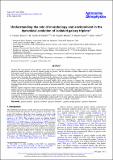Por favor, use este identificador para citar o enlazar a este item:
http://hdl.handle.net/10261/308549COMPARTIR / EXPORTAR:
 SHARE SHARE
 CORE
BASE CORE
BASE
|
|
| Visualizar otros formatos: MARC | Dublin Core | RDF | ORE | MODS | METS | DIDL | DATACITE | |

| Título: | Understanding the role of morphology and environment in the dynamical evolution of isolated galaxy triplets |
Autor: | Vásquez-Bustos, P.; Argudo-Fernandez, M.; Grajales-Medina, D.; Duarte Puertas, Salvador; Verley, S. | Palabras clave: | Galaxies: general Galaxies: evolution Galaxies: formation Galaxies: groups: general Galaxies: interactions |
Fecha de publicación: | 6-feb-2023 | Editor: | EDP Sciences | Citación: | Astronomy & Astrophysics 670: A63 (2023) | Resumen: | Context. The environments where galaxies reside affects their evolutionary histories. Galaxy triplets (systems composed of three physically bound galaxies) are one of simplest groups of galaxies, and are therefore excellent laboratories to study evolutionary mechanisms where effects of the environment are minimal. Aims. We present a statistical study of the dynamical properties of isolated galaxy triplets as a function of their local and large-scale environments. To explore the connection of the dynamical evolution on the systems with the evolution of the galaxies composing the triplets, we consider observational properties such as morphology and star formation rate (SFR). Methods. We used the SDSS-based catalogue of Isolated Triplets (SIT), which contains 315 triplets. We classified each triplet according to galaxy morphologies and defined a parameter Qtrip to quantify the total local tidal strengths in the systems. To quantify the dynamical stage of the system we used the parameters of harmonic radius RH, velocity dispersion σvr, crossing time H0tc, and virial mass Mvir. Results. Triplets composed of three early-type galaxies present the smallest RH, indicating that they are in general more compact than triplets with one or more late-type galaxies. Among triplets with low values of RH and H0tc, SIT triplets with Qtrip < −2 are relaxed systems that are more dynamically evolved, while triplets with Qtrip > −2 show compact configurations due to interactions within the system, such as ongoing mergers. Conclusions. We found that there is no dominant galaxy in triplets in terms of properties of stellar populations such as global colour and SFR. Moreover, the global SFR in isolated triplets composed of two or more early-type galaxies increases with the stellar mass ratio of the galaxies with respect to the central galaxy, therefore the system is globally ‘rejuvenated’. The Authors 2023. | Descripción: | This is an Open Access article, published by EDP Sciences, under the terms of the Creative Commons Attribution License (https://creativecommons.org/licenses/by/4.0), which permits unrestricted use, distribution, and reproduction in any medium, provided the original work is properly cited. | Versión del editor: | http://dx.doi.org/10.1051/0004-6361/202245297 | URI: | http://hdl.handle.net/10261/308549 | DOI: | 10.1051/0004-6361/202245297 | ISSN: | 0004-6361 | E-ISSN: | 1432-0746 |
| Aparece en las colecciones: | (IAA) Artículos |
Ficheros en este ítem:
| Fichero | Descripción | Tamaño | Formato | |
|---|---|---|---|---|
| 2023A&A...670A..63V.pdf | 13,83 MB | Adobe PDF |  Visualizar/Abrir |
CORE Recommender
SCOPUSTM
Citations
1
checked on 21-abr-2024
Page view(s)
18
checked on 30-abr-2024
Download(s)
14
checked on 30-abr-2024
Google ScholarTM
Check
Altmetric
Altmetric
Este item está licenciado bajo una Licencia Creative Commons

